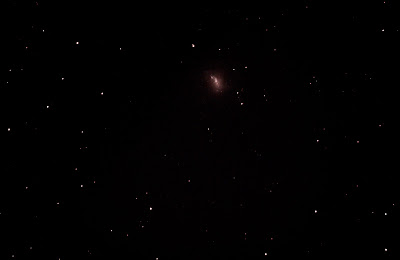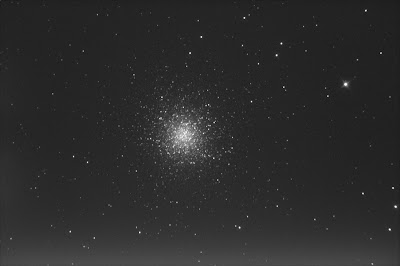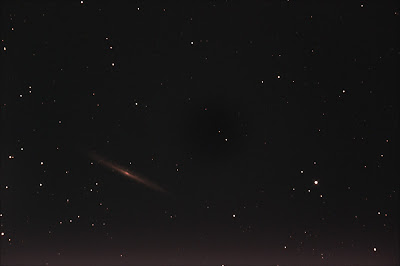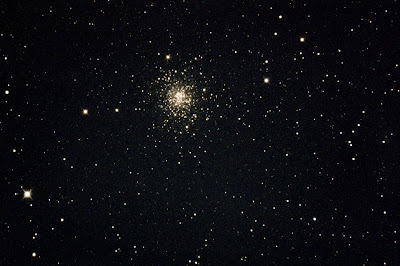July 1, 2017
I had been wondering about the odd
Herschel designations for objects in Deep-Sky Planner. Most places
just reference the NGC #. I found informative web page on Herschel
that provided the following explanation.
<http://www.messier.seds.org/xtra/similar/herschel.html>.
- Bright Nebulae
- Faint Nebulae
- Very faint Nebulae
- Planetary Nebulae
- Very large Nebulae
- Very compressed and rich star clusters
- Compressed clusters of small and large (i.e., faint and bright) stars
- Coarsely scattered clusters of stars
So H 53-4 (NGC 1501, the Oyster Nebula,
a planetary nebula) was the 53rd planetary nebula that he cataloged.
The Astronomical League's web page also contains good information on
Herschel and his nomenclature.
<https://www.astroleague.org/al/obsclubs/herschel/h400lstc.html>
Another hot, muggy night in SE
Louisiana, at least there are no clouds. I built a new dark library
PhD2 from 3 to 6 seconds, 10 exposures each. I'm going to take a
different approach to cooling the ASI071MC-COOL by setting to 0, but
no lower. I've slowly cooled from ambient to 10, 5, and 0.
Hopefully this will avoid fogging of the windows with the window
heater and aux heater on. To start I took 5 darks of 3 min, Gain
400, temp 0 C with the color balance as it was last night (Gamma 100,
brightness 8, R bal 60, B bal 99).
Note that I have yet to drop a single frame on this computer. Makes
observing more enjoyable. With the darks done I'll continue with the
Herschel 400 objects in Ophiuchus. At 2137 it is 78 F with 88%
humidity.
H 12-6, NGC 6293
A circular GC in a dense star field.
Interestingly there are numerous stars in the GC or between the GC &
Earth that are much larger than the majority of the stars in the GC.
The core of the cluster is unfortunately blown out.
I tried to use just SharpCap to stack &
adjust but I find the interface a bit clumsy and in switching from
the stack screen to the histogram, the program froze & I had to
kill it. I collected 6 x 3 min exposures with gain=400 and stacked
in AstroToaster. I'm at 50% on the histogram so more signal than I
typically collect. No stars are blown out but the core is blown out.
I should have reduced the exposure and/or gain to get a better
image.
6 x 180 sec, gain= 400, Temp =0C , dark frame subtraction
H 147-1, NGC 6304
A bright, tight GC in a very dense star
field. The core is not circular but almost rectangular. I've blown
out the core badly with a stack of 5 x 3 min at gain=400. The star
field is so dense it is hard to tell where the GC ends. The FOV is
littered with larger, brighter stars. The star field is densest to
the SE of the GC.
I think the reddish tint is a fog
forming on the camera window or chip. When I up the gain on the
AstroToaster image you can see it. I'll try raising the camera
temperature to 5 C.
5 x 180 sec, gain = 400, Temp = 0C, dark frame subtraction
H 149-1, NGC 6342
The reddish cast is largely gone in
these frames but the image looks washed out and foggy. The histogram
max lies at 35 and the colors are nicely correlated.
An interesting GC as it has 2 linear
extensions to the S. The core is rather diffuse with discernible
stars around the core. The extension on the SW side is the most
prominent with 2 bright lobes and an intermediate semi-bright lobe.
The extension to the SE has only 1 semi-bright lobe nearest the GC
and then 3 fainter lobes. The star field is dense to the E and
especially the SE. There is a single large bright star near the NW
corner of the FOV.
Note that these images are captured in SharpCap and stacked, adjusted, and saved from AstroToaster. No post processing was performed unless explicitly stated.
H 11-4, NGC 6369
This is a faint, 11.4 mag, planetary
nebula and it is only 37.8''. This will be a bit of a challenge for
a 3 min image. First frames look quite nice, like the
ring nebula only smaller and the central star is more obvious. The
width of the ring halo is about double the size of the central hole.
Unlike the M 57 ring nebula, I see no color in this nebula. No
structure is discernible in the halo. In the HST picture there is
nebulosity on opposing sides of the nebula about the width of the
halo away from the halo. I can see hints of this in the N & S of
the nebula but it is not clear in the pictures. There are 2 bright
stars in the FOV. One is near the NW edge and the other is NE of the
nebula by around 10 minutes.
H 46-1, NGC 6355 & H 44-1, NGC
6401
These objects are low in the SE and I
appear to be getting a reflection off the top of the observatory
wall. (I need to paint the top rail flat black to help avoid this.)
I can see the clusters but can not make out any detail due to the
bright reflection. Will try these again when they are higher.
H 199-2, NGC 6517
This object is higher up in the sky so
I hopefully will avoid the reflections that plagued the observation
of the previous 2 objects.
Easily spotted GC in a star field void
of any large, bright stars. The GC has a small bright core and a
star cluster that looks more triangular than circular. This is
evident in some of the pics on the internet of this object.
“Spokes” of the GC point E, NNW, and SSW. To the NNE there are 2
arcs of stars bending off to the SE.
6 x 180 sec, gain = 400, Temp = 0C, dark frame subtraction applied
At 0034 it is 72 F and 98% humidity.
Sky meter reading is 18.43 with a half moon low in the SW.
I got all but 2 of the Herschel 400
objects in Ophiuchus. Will try to nab the last 2 tomorrow night.
Shut down at 0048.
==
July 2, 2017Set up around 2050 on a hot, humid night with clear skies to the E but a few clouds in the W. I don't plan on viewing to the W so we should be OK. My primary goal is to knock out the two remaining Herschel 400 objects in Ophiuchus but I'll need to wait until around 2300 for them to be high enough.
Built model from Vega, Ras Alhague, Kornoeouphus, Antares, & Mizar. I then added Altair and a goto Ras Alhague failed to put it in the FOV. I removed Altair from the alignment and went to Vega, it is NW of Center just outside the second circle of the ShapCap reticle, which is probably around 5 arcmin. Not great but I'll go with it. I have the dew shield on the scope tonight to minimize dew and reflections. I left the camera temperature at 5 C to avoid freezing and/or dewing on the chip window.
H 46-1, NGC 6355
A GC in a densely populated star field except for the Eastern edge of the FOV. The cluster is easily spotted and has a bright core with discernible stars. It is circular in shape with a line of stars on the N edge running W-E made up of around 10 stars. There is a large bright star, perhaps a double, about 25 arc min to the W of the GC.
6 x 180 sec, gain = 400, Temp = 0C, dark frame subtracted
At 2300 it is 79 F and 92% humidity. Sky meter reading is 18.38 with the half moon in the SW.
H 44-1, NGC 6401
Got one frame and then clouds started rolling in and PhD lost its star. I may just have to be satisfied with the couple of frames I got.
This GC doesn't appear to be round but is flat on the NNW side. There is a large bright star on the SSE at the edge of the GC. The GC has no discernible core. The stars are uniform and faint except for 3 bright stars on the NW edge running E-W. The star field is fairly dense especially to the S. There is a large dark area (dark nebula?) to the SE and more smaller dark regions to the NE & NW. These dark regions are seen in pics on the internet and thus not an artifact of my image.
9 x 180 sec, gain = 400,Temp = 0C, dark frame subtracted.
I only got 2 objects done, but at least I finished off the Herschel 400 objects in Ophiuchus. I've now bagged 162 of the 400 objects or 40.5%. Shutdown at 2333.
==
July 3, 2017
Another hot, muggy night in SE LA, but at least it is reasonably clear. There are periodic fireworks going off around the area and a big display by the parish to the NW, so I won't look in that direction.
Setup is the same as the past couple of nights; 10” RC at F8, no focal reducer, ASI071MC-Cool imaging camera at prime focus. Lumicon Deep Sky filter. Orion 80 mm F5 guide scope with StarShoot autoguider camera. Pier mounted Losmandy G11 with Gemini 2 controller. I synced the model on Antares and off I go, although at 2107 it isn't yet quite dark.
H 196-2, NGC 5694
Trying this object although it is rather low (33 degrees) in the SW. A small (1.2')circular GC with a small bright core. Several stars are discernible around the periphery of the GC but the center is blown out. To the SW there is a linear extension of a few stars. There are 2 large bright stars to the NE of the GC about 1 – 1.5' away.
10 x 60 sec exposure, gain = 400, Temp = 5 C, no dark
frames were subtracted.
H 402-2, NGC 6118
This is a faint (11.7 mag) object that is within 30 degrees of the > ½ moon. May not have enough contrast to pull it out of the sky glow. I can see the shape of the galaxy's halo but not discern any detail of the arms. There is a bright core and an elliptical halo that is roughly twice the size in the NE & SW directions as in the NW & SE. There is a line of 4 stars, probably foreground stars, across the NE end of the galaxy running NW to SE. The star field is moderately populated with uniform density, size, & brightness except for 1 brighter star NNE of the GC roughly 20 arcmin away.
10 x 180 sec, gain = 400, Temp = 5C, no dark frames were
subtracted.
At 2246 it is 78 F & 88% humidity. Sky meter reading is 18.49 with a > ½ moon in the SW.
H 10-6, NGC 6144
A large (in my FOV) GC with no detectable core and many discernible stars. In stack of first 4 frames I had egg shaped stars. The mount is leaning pretty far over and part of the scope is blocked by the observatory wall. The stars are egg shaped in single 2 min images so I don't think I'm going to get a decent image. I'm not going to record this observation in Deep-Sky Planner as I need to observe the object again to catch a better look.
4 x 120 sec, gain = 400, Temp = 5C, no dark frames were subtracted
H 47-1, NGC 6712
Wow, hard to believe this object wasn't a Messier or Caldwell as it is big (~ 3 x 4') and bright in a very dense star field. It is hard to discern where the GC ends in this dense star field. The GC isn't circular, at least from the image. It is flat on its NE edge. This is also shown in pics on the internet. There is no bright core to this GC but there are a dozen or so bright stars around the object, but they could be foreground stars. There is a bright star, much more so than the other stars in the FOV, about 5 arcmin to the SSW.
7 x 120 sec, gain = 400, Temp = 5C, no dark frames were subtracted
H 18-7, NGC 6823
Last object of the night, an open cluster in Vulpecula and there appears to be a dark nebula in the DSS picture. Will see what I can pull out.
A very nice bright cluster in a sea of red nebulousity with dark nebulas running through. The cluster has 3 close bright stars at its center with other bright stars in the region and many more smaller stars. The cluster is surrounded by a red nebula with dark lanes and regions (dark nebula?). One prominent dark lane is 5 arcmin SW of the cluster. The surrounding star field is densely populated.
8 x 120 sec, gain = 400, Temp = 5C, no dark frame subtraction
I was afraid I would have star streaks in the above images as I kept loosing the guide star due to clouds rolling in. The sky is now covered and I shut down at 0012.
==
July 5, 2017
Targets for tonight are the remaining objects in the constellations Vulpecula. If time allows the objects in Scutum and Sagittarius will be next. Same setup as on July 3. It is 84 F with 72% humidity at 2055. The skies are clear but the moon is 4 days from full and is thus shinning bright and high in the SE. Did a goto on Alberio and it was very close to center of FOV so I did not do a sync. Onto the first object of the night.
H 14-6, NGC 6802
A stack of 5 x 90 sec images show the cluster nicely in a dense star field, but many of the stars are quite faint so I increased the exposure to 2 min. Interestingly the cluster is not circular but rectangular running SW to NE. It is roughly 5 x 2 arcmin. The cluster consists of 2 brighter stars along the S edge of the cluster. The other stars in the region are quite uniform.
The star field is densely populated with 2 larger stars about 5' to the NW of the cluster. About 10' to the E is a broad (15') curved structure consisting of a dozen stars. There are also collections of brighter stars about 15' to the SE
9 x 120 sec, gain = 400, Temp = 5C, no dark frame subtraction
H 9-7, NGC 6830
A sparse cluster approximately 27 stars arranged in a pattern resembling the numeral 3 with several fainter stars. The star field is densely populated. There are 2 brighter stars around 5 arcmin to the SSE.
8 x 120 sec, gain = 400, Temp = 5C, no dark frame subtraction
H 22-8, NGC 6882
A large loose cluster that is marked by a large bright star near the S border, although the borders of the cluster are hard to discern. There is a circle of stars about 3 arcmin in diameter to the NW of the bright star by about 5 arcmin. Around this bright star are 11 stars of intermediate brightness and many more fainter stars. 20 arcmin to the W of the central star of the cluster is a much larger brighter star that I believe is 20 Vulpecula.
6 x 120 sec, gain = 400, Temp = 5C, no dark frame subtraction
Astrometry.net found this image to be 40.5 x 26.9 arc min with 0.492 arcsec/pixel. It said that the object in the center of the FOV is NGC 6885 with 20 Vul being the central star. It says that NGC 6882 is around the very bright star to the WSW, what I thought was 20 Vulpecula, but astrometry.net calls it 19 Vul. The Sky Atlas 2000.0 also shows NGC 6882 around 19 Vul and 6885 around 20 Vul.
Crap, clouds are starting to roll in all around. Hopefully I can finish the objects in Vulpecula.
H 20-8, NGC 6885
The image captured is nearly identical to the one for NGC 6882 so the Gemini system has the same coordinates for these two objects.
6 x 120 sec, gain = 400, Temp = 5C, no dark frame subtraction
Found this info on www.freestarcharts.com
NGC 6882/6885- open clusters NGC 6882 and NGC 6885 may or may not be the same item. William Herschel discovered them on successive nights and gave almost identical descriptions. General consensus is they are the same object. To complicate the story further, Per Collinder included a small scattering of stars to the northwest edge of NGC 6882/6885 as number (Cr) 416 in his catalogue of open clusters.
NGC 6882/6885 is grouped around mag. +5.9 star 20 Vulpeculae and consists of up to 40 stars. The rough diameter of the cluster is about 20 arc minutes with the more compact cluster Cr 416 located at the northwest corner (diameter 8 arc minutes). NGC 6882/6885 shines at mag. +5.5, with Cr 416 fainter at mag. +8.1. All in all, the whole area contains a nice grouping of stars centred on bright stand out star, 20 Vulpeculae. Binoculars show the main stars and give a feeling for the area, medium and large size telescopes reveal much more. To some, the region appears as just one large group of stars.
In his book Deep Sky Companions: The Caldwell Objects, author Steve O'Meara, in chapter 37 discusses the NGC 6885 / 6882 confusion in detail but provide no resolution: 2 objects or 1.
H 8-7, NGC 6940
A large star cluster centered on a bright reddish star in dense star field. Difficult to discern where the cluster boundaries are. I can discern no patterns or asterisms in this cluster. It appears to be oriented NE to SW and covers almost the entire FOV. It is cited to be 25 arcmin and my FOV is 40.5 x 26.9 arc min, so that makes sense. Interesting that Astrometry.net doesn't label the central star.
6 x 120 sec, gain = 400, Temp = 5C, no dark frame subtraction
At 2349 the sky meter reading is 18.41 and it is 77 F and 92% humidity. Shutting down for the night having achieved my goal of viewing the Herschel 400 objects in Vulpecula.
==
July 30, 2017
A front blew through yesterday and we had beautiful blue skies and tonight they are nice and clear. There is a half moon high in the S, but the skies are free of clouds. At 2148 it is 83 F and 58% humidity. First time out in a long time. Setup the ASI071MC-COOL at prime focus again with the Lumicon DS filter. Aligned on Arcturus and then setup to work on the Herschel 400, starting in Scorpius and Sagittarius
H 10-6, NGC 6144
The target was just off screen to the SW. I was able to center the object for observation, but I'm going to need to adjust the model before I move to other objects. This object is 29,000 ly from the sun, magnitude 9.0 v, and is 7.4 arcmin in size. It is a densely populated GC in a moderately populated star field. The field is void of any significantly larger / brighter stars. The GC core reveals many discrete stars. There is a pattern resembling a Fleur de lis with the orientation N.
10 x 60 sec, gain = 400, Temp = 0C, no dark frame subtraction
I did an alignment on Kaus Austraslis and tweaked the focus with the Bahtinov mask and the SharpCap focus assist routine.
H 13-6, NGC 6451
A cluster of over 2 dozen stars, most similarly sized & brightness. The shape is ill defined but I see a V pointing E with an appendage off the N circling to the E, terminating in a 3 star line with a fourth star to the NE over the center star in the line. The star field is very densely populated with a faint red nebulosity in the background to the W through the NNE.
11 x 60 sec, gain = 400, Temp = 0C, no dark frame subtraction
H 150-1, NGC 6440
A small (4') GC in a dense star field, but with some dark lanes to the NE (dark nebula?). The GC stars look red orange compared to the white surrounding stars. The GC has a large bright star to the SE about 10' from the center of the GC. There is another larger bright star to the WNE about 15' from the GC center. Even at 30 sec the inner core in a line running NNE by SSW is blown out so I'll just stick with my 60 sec exposures as to capture more fainter stars.
13 x 60 sec, gain = 400, Temp = 0C, no dark frame subtraction
Here is a crop of the above image.
H 586-2, NGC 6445
This object is only about 20' from NGC 6440 and I got them both in frame. The small (~ 1') nebula is surprisingly a rectangular shape rather than round. There is some reddish color around the edges but it is mostly white. It is hollow in the center. The star field is densely populated with one star that is much larger and brighter than the others about 15' to the SE.
9 x 180 sec, gain = 400, Temp = 0C, no dark frame subtraction
At midnight the sky meter reading was 18.81 and the temp is 73 F with 82% humidity. There are some high thin clouds to the East. It was supposed to be clear tonight!
H 31-7, NGC 6583
A small cluster in a very dense star field. The cluster is rectangular in shape running NE to SW. To the W are 3 larger / brighter stars in a line oriented NW to the S about 3' from the cluster center. Within the cluster there is an line of 6 stars arcing to the NE and then E. In the FOV to the NE is a brighter star( the brightest in the FOV) and about 12' from the cluster's center. The star is bounded by 4 bright stars; 2 to the S and 2 to the E. There is a 5' line of 4 stars running NE from the bright star with the last 2 being within 1' of each other.
10 x 60 sec, gain = 400, Temp = 0C, no dark frame subtraction
Shutdown at 0035.




























































